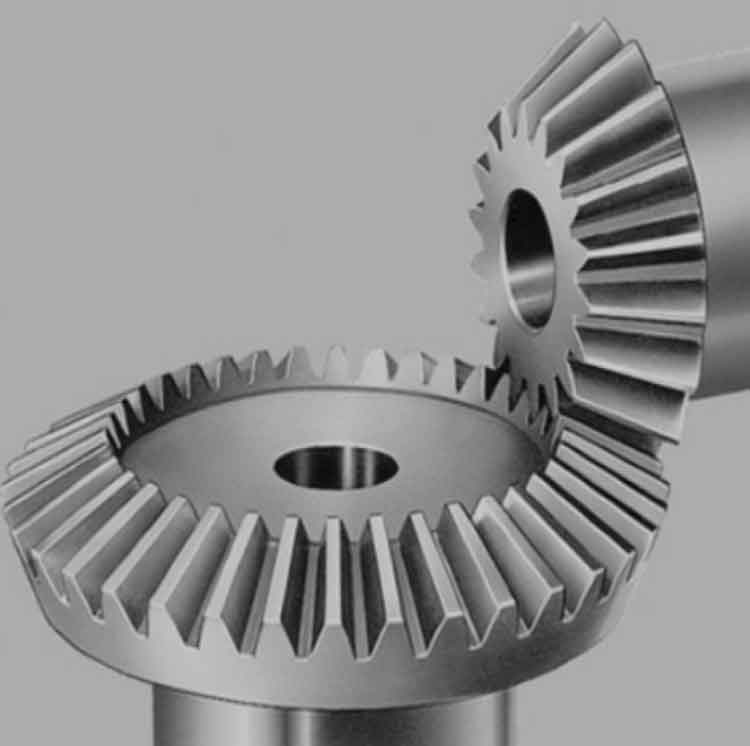Straight bevel gears are a type of bevel gear used to transmit power and motion between intersecting shafts at a right angle. They have conical-shaped teeth that are straight and taper towards the gear’s apex. In this discussion, we will explore the design, function, and applications of straight bevel gears.

Design of Straight Bevel Gears:
Straight bevel gears are typically designed using standard gear design principles. The primary design considerations include:
- Gear Ratio: The gear ratio determines the speed and torque relationship between the driving and driven shafts. It is defined as the ratio of the number of teeth on the driving gear to the number of teeth on the driven gear.
- Tooth Profile: The teeth of straight bevel gears have a straight shape and taper towards the apex. The tooth profile must be designed to ensure smooth and efficient power transmission.
- Pitch Angle: The pitch angle is the angle between the gear’s tooth face and its axis. In straight bevel gears, the pitch angle is usually 90 degrees since these gears are designed to transmit motion at a right angle.
- Module or Diametral Pitch: The module or diametral pitch determines the size and spacing of the teeth. It is an important factor in gear design, and it affects the gear’s strength and load-carrying capacity.
- Materials and Manufacturing: Straight bevel gears are commonly made from materials such as alloy steels, hardened steel, or cast iron. The manufacturing process involves cutting the gear teeth using milling or hobbing techniques.
Function of Straight Bevel Gears:
Straight bevel gears serve the purpose of transmitting power and motion between intersecting shafts. When the driving gear rotates, it meshes with the driven gear, transferring rotational motion and torque. The gear teeth engage and disengage as they rotate, ensuring a continuous and smooth transmission of power.
The primary function of straight bevel gears includes:
- Changing Shaft Direction: Straight bevel gears are commonly used when there is a need to change the direction of rotation by 90 degrees. They transmit motion between two intersecting shafts at a right angle.
- Power Transmission: Straight bevel gears can transmit high power and torque. They are used in various mechanical systems where the input and output shafts need to transfer substantial rotational force.
- Speed Reduction or Increase: By selecting different gear ratios, straight bevel gears can be used to either reduce or increase the rotational speed between the driving and driven shafts.
Applications of Straight Bevel Gears:
Straight bevel gears find applications in numerous industries and mechanical systems. Some common applications include:
- Automotive Industry: Straight bevel gears are used in automotive differentials to transfer power from the drive shaft to the wheels while allowing them to rotate at different speeds. They are also employed in power steering systems and manual transmissions.
- Industrial Machinery: Straight bevel gears are utilized in various industrial machinery, such as machine tools, printing presses, conveyors, and packaging equipment. They facilitate the transfer of power and motion in these machines.
- Marine Propulsion: Straight bevel gears are used in marine propulsion systems to transmit power from the engine to the propeller shaft, enabling the vessel to move efficiently through water.
- Aerospace Industry: Straight bevel gears are employed in aerospace applications, including helicopter transmissions, landing gear systems, and engine accessories.
- Power Plants: Straight bevel gears can be found in power plants, where they are used in turbines, generators, and other equipment that require the transmission of high power and torque.
- Mining and Heavy Machinery: Straight bevel gears are utilized in mining equipment, construction machinery, and heavy-duty vehicles for power transmission and changing shaft direction.
Overall, the design, function, and applications of straight bevel gears make them an essential component in various mechanical systems that require the efficient transmission of power and motion at a right angle.
